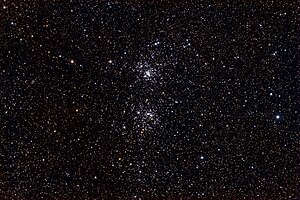|
S Persei adalah bintang super raksasa merah atau hiper raksasa yang terletak di dekat Double Cluster di Perseus, utara gugus NGC 869. Ini adalah anggota asosiasi Perseus OB1 dan salah satu bintang terbesar yang diketahui. Jika ditempatkan di tata surya, permukaannya akan menelan orbit Jupiter. Bintang Ini juga merupakan variabel semiregular, bintang yang variasinya kurang teratur dibandingkan dengan variabel mira.
Penemuan
S Persei dinamai oleh astronom Jerman Adalbert Krueger pada tahun 1874 setelah mengamati bahwa kecerahannya bervariasi.[12] Ia kemudian terdaftar dalam katalog bintang utama pada era itu sebagai HD 14528 dan BD + 57° 552.
Referensi
- ^ a b Van Leeuwen, F. (2007). "Validation of the new Hipparcos reduction". Astronomy and Astrophysics. 474 (2): 653–664. arXiv:0708.1752
 . Bibcode:2007A&A...474..653V. doi:10.1051/0004-6361:20078357. . Bibcode:2007A&A...474..653V. doi:10.1051/0004-6361:20078357.
- ^ a b c d Emily M. Levesque; Philip Massey; K. A. G. Olsen; Bertrand Plez; et al. (August 2005). "The Effective Temperature Scale of Galactic Red Supergiants: Cool, but Not As Cool As We Thought". The Astrophysical Journal. 628 (2): 973–985. arXiv:astro-ph/0504337
 . Bibcode:2005ApJ...628..973L. doi:10.1086/430901. . Bibcode:2005ApJ...628..973L. doi:10.1086/430901.
- ^ a b c Samus', N. N.; Goranskii, V. P.; Durlevich, O. V.; Zharova, A. V.; Kazarovets, E. V.; Kireeva, N. N.; Pastukhova, E. N.; Williams, D. B.; Hazen, M. L. (2003). "An Electronic Version of the Second Volume of the General Catalogue of Variable Stars with Improved Coordinates". Astronomy Letters. 29 (7): 468. Bibcode:2003AstL...29..468S. doi:10.1134/1.1589864.
- ^ Famaey, B.; Jorissen, A.; Luri, X.; Mayor, M.; Udry, S.; Dejonghe, H.; Turon, C. (2005). "Local kinematics of K and M giants from CORAVEL/Hipparcos/Tycho-2 data". Astronomy and Astrophysics. 430 (1): 165–186. arXiv:astro-ph/0409579
 . Bibcode:2005A&A...430..165F. doi:10.1051/0004-6361:20041272. ISSN 0004-6361. . Bibcode:2005A&A...430..165F. doi:10.1051/0004-6361:20041272. ISSN 0004-6361.
- ^ a b c Asaki, Y.; Deguchi, S.; Imai, H.; Hachisuka, K.; Miyoshi, M.; Honma, M. (2010). "Distance and Proper Motion Measurement of the Red Supergiant, S Persei, with Vlbi H2O Maser Astrometry". The Astrophysical Journal. 721 (1): 267–277. arXiv:1007.4874
 . Bibcode:2010ApJ...721..267A. doi:10.1088/0004-637X/721/1/267. ISSN 0004-637X. . Bibcode:2010ApJ...721..267A. doi:10.1088/0004-637X/721/1/267. ISSN 0004-637X.
- ^ Yates, J. A.; Cohen, R. J. (1994). "Circumstellar Envelope Structure of Late Type Stars as Revealed by MERLIN Observations of 22-GHZ Water Masers". Monthly Notices of the Royal Astronomical Society. 270 (4): 958. Bibcode:1994MNRAS.270..958Y. doi:10.1093/mnras/270.4.958.
- ^ Norris, Ryan P. (2019). Seeing Stars Like Never Before: A Long-term Interferometric Imaging Survey of Red Supergiants (Tesis PhD). Georgia State University. https://core.ac.uk/download/pdf/225164189.pdf.
- ^ Davies, Ben; Beasor, Emma R. (March 2020). "The 'red supergiant problem': the upper luminosity boundary of Type II supernova progenitors". MNRAS (dalam bahasa Inggris). 493 (1): 468–476. arXiv:2001.06020
 . Bibcode:2020MNRAS.493..468D. doi:10.1093/mnras/staa174. . Bibcode:2020MNRAS.493..468D. doi:10.1093/mnras/staa174.
- ^ Gonzalez, Guillermo; Wallerstein, George (2000). "Elemental Abundances in Evolved Supergiants. II. The Young Clusters H and χ Persei". The Astronomical Journal. 119 (4): 1839. Bibcode:2000AJ....119.1839G. doi:10.1086/301319
 . .
- ^ García-Hernández, D. A.; García-Lario, P.; Plez, B.; Manchado, A.; d'Antona, F.; Lub, J.; Habing, H. (2007). "Lithium and zirconium abundances in massive Galactic O-rich AGB stars". Astronomy and Astrophysics. 462 (2): 711. arXiv:astro-ph/0609106
 . Bibcode:2007A&A...462..711G. doi:10.1051/0004-6361:20065785. . Bibcode:2007A&A...462..711G. doi:10.1051/0004-6361:20065785.
- ^ Gordon, Michael S.; Humphreys, Roberta M.; Jones, Terry J.; Shenoy, Dinesh; Gehrz, Robert D.; Helton, L. Andrew; Marengo, Massimo; Hinz, Philip M.; Hoffmann, William F. (2018). "Searching for Cool Dust. II. Infrared Imaging of the OH/IR Supergiants, NML Cyg, VX SGR, S Per, and the Normal Red Supergiants RS per and T per". The Astronomical Journal. 155 (5): 212. arXiv:1708.00018
 . Bibcode:2018AJ....155..212G. doi:10.3847/1538-3881/aab961. . Bibcode:2018AJ....155..212G. doi:10.3847/1538-3881/aab961.
- ^ Krüger, A. (1874). "Anzeige eines neuen veränderlichen Sternes (S Persei)". Astronomische Nachrichten. 83 (10): 157–158. doi:10.1002/asna.18740831005. ISSN 0004-6337.
|
